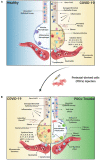Perinatal Cells: A Promising COVID-19 Therapy?
- PMID: 33520970
- PMCID: PMC7841388
- DOI: 10.3389/fbioe.2020.619980
Perinatal Cells: A Promising COVID-19 Therapy?
Abstract
The COVID-19 pandemic has become a priority in the health systems of all nations worldwide. In fact, there are currently no specific drugs or preventive treatments such as vaccines. The numerous therapies available today aim to counteract the symptoms caused by the viral infection that in some subjects can evolve causing acute respiratory distress syndromes (ARDS) with consequent admission to intensive care unit. The exacerbated response of the immune system, through cytokine storm, causes extensive damage to the lung tissue, with the formation of edema, fibrotic tissues and susceptibility to opportunistic infections. The inflammatory picture is also aggravated by disseminated intravascular coagulation which worsens the damage not only to the respiratory system, but also to other organs. In this context, perinatal cells represent a valid strategy thanks to their strong immunomodulatory potential, their safety profile, the ability to reduce fibrosis and stimulate reparative processes. Furthermore, perinatal cells exert antibacterial and antiviral actions. This review therefore provides an overview of the characteristics of perinatal cells with a particular focus on the beneficial effects that they could have in patients with COVID-19, and more specifically for their potential use in the treatment of ARDS and sepsis.
Keywords: PLacental eXpanded; coronavirus-induced disease 2019; mesenchymal stromal cells; perinatal; severe acute respiratory distress syndrome coronavirus-2.
Copyright © 2021 Papait, Cargnoni, Sheleg, Silini, Kunis, Ofir and Parolini.
Conflict of interest statement
MS, GK, and RO are employed by the company Pluristem Ltd. The remaining authors declare that the research was conducted in the absence of any commercial or financial relationships that could be construed as a potential conflict of interest.
Figures


Similar articles
-
Umbilical Cord-derived Mesenchymal Stem Cells for COVID-19 Patients with Acute Respiratory Distress Syndrome (ARDS).CellR4 Repair Replace Regen Reprogram. 2020;8:e2839. doi: 10.32113/cellr4_20204_2839. Epub 2020 Apr 28. CellR4 Repair Replace Regen Reprogram. 2020. PMID: 34164564 Free PMC article.
-
Expanded Umbilical Cord Mesenchymal Stem Cells (UC-MSCs) as a Therapeutic Strategy in Managing Critically Ill COVID-19 Patients: The Case for Compassionate Use.Pain Physician. 2020 Mar;23(2):E71-E83. Pain Physician. 2020. PMID: 32214286
-
Facing the Challenges in the COVID-19 Pandemic Era: From Standard Treatments to the Umbilical Cord-Derived Mesenchymal Stromal Cells as a New Therapeutic Strategy.Cells. 2023 Jun 19;12(12):1664. doi: 10.3390/cells12121664. Cells. 2023. PMID: 37371134 Free PMC article. Review.
-
Immunomodulatory agents as potential therapeutic or preventive strategies for COVID-19.Eur Rev Med Pharmacol Sci. 2021 Jun;25(11):4174-4184. doi: 10.26355/eurrev_202106_26061. Eur Rev Med Pharmacol Sci. 2021. PMID: 34156699 Review.
-
Heme oxygenase-1 (HO-1) cytoprotective pathway: A potential treatment strategy against coronavirus disease 2019 (COVID-19)-induced cytokine storm syndrome.Med Hypotheses. 2020 Nov;144:110242. doi: 10.1016/j.mehy.2020.110242. Epub 2020 Sep 3. Med Hypotheses. 2020. PMID: 33254548 Free PMC article.
Cited by
-
Biological importance of human amniotic membrane in tissue engineering and regenerative medicine.Mater Today Bio. 2023 Sep 1;22:100790. doi: 10.1016/j.mtbio.2023.100790. eCollection 2023 Oct. Mater Today Bio. 2023. PMID: 37711653 Free PMC article. Review.
-
Perspectives on the use of decellularized/devitalized and lyophilized human perinatal tissues for bone repair: Advantages and remaining challenges.Mater Today Bio. 2024 Nov 26;30:101364. doi: 10.1016/j.mtbio.2024.101364. eCollection 2025 Feb. Mater Today Bio. 2024. PMID: 39811604 Free PMC article.
-
HIPGEN: a randomized, multicentre phase III study using intramuscular PLacenta-eXpanded stromal cells therapy for recovery following hip fracture arthroplasty : a study design.Bone Jt Open. 2022 Apr;3(4):340-347. doi: 10.1302/2633-1462.34.BJO-2021-0156.R1. Bone Jt Open. 2022. PMID: 35451865 Free PMC article.
-
Therapeutic Potential of Mesenchymal Stem Cells and Their Products in Lung Diseases-Intravenous Administration versus Inhalation.Pharmaceutics. 2021 Feb 7;13(2):232. doi: 10.3390/pharmaceutics13020232. Pharmaceutics. 2021. PMID: 33562240 Free PMC article. Review.
-
Application of Perinatal Derivatives on Oncological Preclinical Models: A Review of Animal Studies.Int J Mol Sci. 2022 Aug 2;23(15):8570. doi: 10.3390/ijms23158570. Int J Mol Sci. 2022. PMID: 35955703 Free PMC article. Review.
References
-
- Allen H., Shraga-Heled N., Blumenfeld M., Dego-Ashto T., Fuchs-Telem D., Gilert A., et al. . (2018). Human placental-derived adherent stromal cells co-induced with TNF-alpha and IFN-gamma inhibit triple-negative breast cancer in nude mouse xenograft models. Sci. Rep. 8:670. 10.1038/s41598-017-18428-1 - DOI - PMC - PubMed
-
- Amari A., Ebtekar M., Moazzeni S. M., Soleimani M., Amirabad L. M., Tahoori M. T., et al. . (2015). Investigation of immunomodulatory properties of human Wharton's Jelly-derived mesenchymal stem cells after lentiviral transduction. Cell. Immunol. 293, 59–66. 10.1016/j.cellimm.2014.12.003 - DOI - PubMed
Publication types
LinkOut - more resources
Full Text Sources
Other Literature Sources

